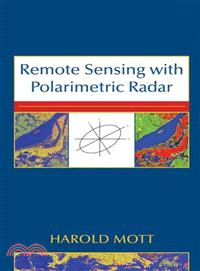Remote Sensing With Polarimetric Radar
商品資訊
ISBN13:9780470074763
出版社:John Wiley & Sons Inc
作者:Mott
出版日:2006/12/14
裝訂/頁數:精裝/328頁
定價
:NT$ 7028 元優惠價
:90 折 6325 元
若需訂購本書,請電洽客服 02-25006600[分機130、131]。
商品簡介
作者簡介
目次
相關商品
商品簡介
Discover the principles and techniques of remote sensing with polarimetric radar
This book presents the principles central to understanding polarized wave transmission, scattering, and reception in communication systems and polarimetric and non-polarimetric radar. Readers gain new insight into the methods for remotely gathering data about the earth's surface and atmosphere with polarimetric synthetic-aperture radar and polarimetric interferometry, including the changes that take place with seasons, floods, earthquakes, and other natural phenomena. In particular, with the book's focus on polarimetric radars, readers discover how to exploit the many special features of these systems, which provide the maximum amount of information that can be obtained remotely with radar.
Introductory-level coverage of electromagnetic wave propagation, antennas, radar and synthetic aperture radar, probability and random processes, and radar interferometry serves as a foundation for advancing to more complex material. A more advanced mathematical and technical treatment enables readers to fully grasp polarized wave transmission, propagation, and reception in communication systems and polarimetric-radar remote sensing. Readers will discover much new material in this text, including:
Distinguishing between coherently-measured and incoherently-measured target matrices for power, recognizing that the two matrix types are not equivalent in representing targets
Removing unpolarized components from the scattered wave and deriving a target matrix for classification from the resulting coherently-scattered wave
Selecting an antenna polarization to maximize the contrast between desired and undesired depolarizing targets
Problems ranging in complexity from introductory to challenging are presented throughout the text.
Engineers will find this an ideal reference to help them fully utilize the powerful capabilities of polarimetric radar. It will also help agronomists, geographers, meteorologists, and other scientists who use remotely obtained data about the earth to evaluate procedures and better interpret the data. The book can also be tailored to both undergraduate and graduate courses in remote sensing, and recommendations are given for text material suitable for such courses.
This book presents the principles central to understanding polarized wave transmission, scattering, and reception in communication systems and polarimetric and non-polarimetric radar. Readers gain new insight into the methods for remotely gathering data about the earth's surface and atmosphere with polarimetric synthetic-aperture radar and polarimetric interferometry, including the changes that take place with seasons, floods, earthquakes, and other natural phenomena. In particular, with the book's focus on polarimetric radars, readers discover how to exploit the many special features of these systems, which provide the maximum amount of information that can be obtained remotely with radar.
Introductory-level coverage of electromagnetic wave propagation, antennas, radar and synthetic aperture radar, probability and random processes, and radar interferometry serves as a foundation for advancing to more complex material. A more advanced mathematical and technical treatment enables readers to fully grasp polarized wave transmission, propagation, and reception in communication systems and polarimetric-radar remote sensing. Readers will discover much new material in this text, including:
Distinguishing between coherently-measured and incoherently-measured target matrices for power, recognizing that the two matrix types are not equivalent in representing targets
Removing unpolarized components from the scattered wave and deriving a target matrix for classification from the resulting coherently-scattered wave
Selecting an antenna polarization to maximize the contrast between desired and undesired depolarizing targets
Problems ranging in complexity from introductory to challenging are presented throughout the text.
Engineers will find this an ideal reference to help them fully utilize the powerful capabilities of polarimetric radar. It will also help agronomists, geographers, meteorologists, and other scientists who use remotely obtained data about the earth to evaluate procedures and better interpret the data. The book can also be tailored to both undergraduate and graduate courses in remote sensing, and recommendations are given for text material suitable for such courses.
作者簡介
HAROLD MOTT, PhD, is Professor Emeritus of Electrical Engineering at the University of Alabama. Dr. Mott has carried out polarimetric-radar research for NASA and NRL, and has consulted extensively with the Army Missile Command on radar environmental modeling. He is the author of Polarization in Antennas and Radar and Antennas for Radar and Communications: A Polarimetric Approach (both published by Wiley).
目次
PREFACE.
ACKNOWLEDGMENTS.
1. ELECTROMAGNETIC WAVES.
1.1. The Time-Invariant Maxwell Equations.
1.2. The Electromagnetic Traveling Wave.
1.3. Power Density.
1.4. The Polarization Ellipse.
1.5. Polarization Vector and Polarization Ratio.
1.6. Circular Wave Components.
1.7. Change of Polarization Basis.
1.8. Ellipse Characteristics in Terms of P and Q.
1.9. Coherency and Stokes Vectors.
1.10. The Poincar´e Sphere.
References.
Problems.
2. ANTENNAS.
2.1. Elements of the Antenna System.
2.2. The Vector Potentials.
2.3. Solutions for the Vector Potentials.
2.4. Far-Zone Fields.
2.5. Radiation Pattern.
2.6. Gain and Directivity.
2.7. The Receiving Antenna.
2.8. Transmission Between Antennas.
2.9. Antenna Arrays.
2.10. Effective Length of an Antenna.
2.11. Reception of Completely Polarized Waves.
2.12. Gain, Effective Area, and Radiation Resistance.
2.13. Maximum Received Power.
2.14. Polarization Efficiency.
2.15. The Modified Friis Transmission Equation.
2.16. Alignment of Antennas.
References.
Problems.
3. COHERENTLY SCATTERING TARGETS.
3.1. Radar Targets.
3.2. The Jones Matrix.
3.3. The Sinclair Matrix.
3.4. Matrices With Relative Phase.
3.5. FSA–BSA Conventions.
3.6. Relationship Between Jones and Sinclair Matrices.
3.7. Scattering with Circular Wave Components.
3.8. Backscattering.
3.9. Polarization Ratio of the Scattered Wave.
3.10. Change of Polarization Basis: The Scattering Matrix.
3.11. Polarizations for Maximum and Minimum Power.
3.12. The Polarization Fork.
3.13. Nonaligned Coordinate Systems.
3.14. Determination of Scattering Parameters.
References.
Problems.
4. AN INTRODUCTION TO RADAR.
4.1. Pulse Radar.
4.2. CW Radar.
4.3. Directional Properties of Radar Measurements.
4.4. Resolution.
4.5. Imaging Radar.
4.6. The Traditional Radar Equation.
4.7. The Polarimetric Radar Equation.
4.8. A Polarimetric Radar.
4.9. Noise.
References.
Problems.
5. SYNTHETIC APERTURE RADAR.
5.1. Creating a Terrain Map.
5.2. Range Resolution.
5.3. Azimuth Resolution.
5.4. Geometric Factors.
5.5. Polarimetric SAR.
5.6. SAR Errors.
5.7. Height Measurement.
5.8. Polarimetric Interferometry.
5.9. Phase Unwrapping.
References.
Problems.
6. PARTIALLY POLARIZED WAVES.
6.1. Representation of the Fields.
6.2. Representation of Partially Polarized Waves.
6.3. Reception of Partially Polarized Waves.
References.
Problems.
7. SCATTERING BY DEPOLARIZING TARGETS.
7.1. Targets.
7.2. Averaging the Sinclair Matrix.
7.3. The Kronecker-Product Matrices.
7.4. Matrices for a Depolarizing Target: Coherent Measurement.
7.5. Incoherently Measured Target Matrices.
7.6. Matrix Properties and Relationships.
7.7. Modified Matrices.
7.8. Names.
7.9. Additional Target Information.
7.10. Target Covariance and Coherency Matrices.
7.11. A Scattering Matrix with Circular Components.
7.12. The Graves Power Density Matrix.
7.13. Measurement Considerations.
7.14. Degree of Polarization and Polarimetric Entropy.
7.15. Variance of Power.
7.16. Summary of Power Equations and Matrix Relationships.
References.
Problems.
8. OPTIMAL POLARIZATIONS FOR RADAR.
8.1. Antenna Selection Criteria.
8.2. Lagrange Multipliers.
A. COHERENTLY SCATTERING TARGETS.
8.3. Maximum Power.
8.4. Power Contrast: Backscattering.
B. DEPOLARIZING TARGETS.
8.5. Iterative Procedure for Maximizing Power Contrast.
8.6. The Backscattering Covariance Matrix.
8.7. The Bistatic Covariance Matrix.
8.8. Maximizing Power Contrast by Matrix Decomposition.
8.9. Optimization with the Graves Matrix.
References.
Problems.
9. CLASSIFICATION OF TARGETS.
A. CLASSIFICATION CONCEPTS.
9.1. Representation and Classification of Targets.
9.2. Bayes Decision Rule.
9.3. The Neyman-Pearson Decision Rule.
9.4. Bayes Error Bounds.
9.5. Estimation of Parameters from Data.
9.6. Nonparametric Classification.
B. CLASSIFICATION BY MATRIX DECOMPOSITION.
9.7. Coherent Decomposition.
9.8. Decomposition of Power-Type Matrices.
C. REMOVAL OF UNPOLARIZED SCATTERING.
9.9. Decomposition of the D Matrix.
9.10. Polarized Clutter.
9.11. A Similar Decomposition.
9.12. Polarimetric Similarity Classification.
References.
Problems.
APPENDIX A. FADING AND SPECKLE.
Reference.
APPENDIX B. PROBABILITY AND RANDOM PROCESSES.
B.1. Probability.
B.2. Random Variables.
B.3. Random Vectors.
B.4. Probability Density Functions in Remote Sensing.
B.5. Random Processes.
References.
APPENDIX C. THE KENNAUGH MATRIX.
APPENDIX D. BAYES ERROR BOUNDS.
References.
INDEX.
ACKNOWLEDGMENTS.
1. ELECTROMAGNETIC WAVES.
1.1. The Time-Invariant Maxwell Equations.
1.2. The Electromagnetic Traveling Wave.
1.3. Power Density.
1.4. The Polarization Ellipse.
1.5. Polarization Vector and Polarization Ratio.
1.6. Circular Wave Components.
1.7. Change of Polarization Basis.
1.8. Ellipse Characteristics in Terms of P and Q.
1.9. Coherency and Stokes Vectors.
1.10. The Poincar´e Sphere.
References.
Problems.
2. ANTENNAS.
2.1. Elements of the Antenna System.
2.2. The Vector Potentials.
2.3. Solutions for the Vector Potentials.
2.4. Far-Zone Fields.
2.5. Radiation Pattern.
2.6. Gain and Directivity.
2.7. The Receiving Antenna.
2.8. Transmission Between Antennas.
2.9. Antenna Arrays.
2.10. Effective Length of an Antenna.
2.11. Reception of Completely Polarized Waves.
2.12. Gain, Effective Area, and Radiation Resistance.
2.13. Maximum Received Power.
2.14. Polarization Efficiency.
2.15. The Modified Friis Transmission Equation.
2.16. Alignment of Antennas.
References.
Problems.
3. COHERENTLY SCATTERING TARGETS.
3.1. Radar Targets.
3.2. The Jones Matrix.
3.3. The Sinclair Matrix.
3.4. Matrices With Relative Phase.
3.5. FSA–BSA Conventions.
3.6. Relationship Between Jones and Sinclair Matrices.
3.7. Scattering with Circular Wave Components.
3.8. Backscattering.
3.9. Polarization Ratio of the Scattered Wave.
3.10. Change of Polarization Basis: The Scattering Matrix.
3.11. Polarizations for Maximum and Minimum Power.
3.12. The Polarization Fork.
3.13. Nonaligned Coordinate Systems.
3.14. Determination of Scattering Parameters.
References.
Problems.
4. AN INTRODUCTION TO RADAR.
4.1. Pulse Radar.
4.2. CW Radar.
4.3. Directional Properties of Radar Measurements.
4.4. Resolution.
4.5. Imaging Radar.
4.6. The Traditional Radar Equation.
4.7. The Polarimetric Radar Equation.
4.8. A Polarimetric Radar.
4.9. Noise.
References.
Problems.
5. SYNTHETIC APERTURE RADAR.
5.1. Creating a Terrain Map.
5.2. Range Resolution.
5.3. Azimuth Resolution.
5.4. Geometric Factors.
5.5. Polarimetric SAR.
5.6. SAR Errors.
5.7. Height Measurement.
5.8. Polarimetric Interferometry.
5.9. Phase Unwrapping.
References.
Problems.
6. PARTIALLY POLARIZED WAVES.
6.1. Representation of the Fields.
6.2. Representation of Partially Polarized Waves.
6.3. Reception of Partially Polarized Waves.
References.
Problems.
7. SCATTERING BY DEPOLARIZING TARGETS.
7.1. Targets.
7.2. Averaging the Sinclair Matrix.
7.3. The Kronecker-Product Matrices.
7.4. Matrices for a Depolarizing Target: Coherent Measurement.
7.5. Incoherently Measured Target Matrices.
7.6. Matrix Properties and Relationships.
7.7. Modified Matrices.
7.8. Names.
7.9. Additional Target Information.
7.10. Target Covariance and Coherency Matrices.
7.11. A Scattering Matrix with Circular Components.
7.12. The Graves Power Density Matrix.
7.13. Measurement Considerations.
7.14. Degree of Polarization and Polarimetric Entropy.
7.15. Variance of Power.
7.16. Summary of Power Equations and Matrix Relationships.
References.
Problems.
8. OPTIMAL POLARIZATIONS FOR RADAR.
8.1. Antenna Selection Criteria.
8.2. Lagrange Multipliers.
A. COHERENTLY SCATTERING TARGETS.
8.3. Maximum Power.
8.4. Power Contrast: Backscattering.
B. DEPOLARIZING TARGETS.
8.5. Iterative Procedure for Maximizing Power Contrast.
8.6. The Backscattering Covariance Matrix.
8.7. The Bistatic Covariance Matrix.
8.8. Maximizing Power Contrast by Matrix Decomposition.
8.9. Optimization with the Graves Matrix.
References.
Problems.
9. CLASSIFICATION OF TARGETS.
A. CLASSIFICATION CONCEPTS.
9.1. Representation and Classification of Targets.
9.2. Bayes Decision Rule.
9.3. The Neyman-Pearson Decision Rule.
9.4. Bayes Error Bounds.
9.5. Estimation of Parameters from Data.
9.6. Nonparametric Classification.
B. CLASSIFICATION BY MATRIX DECOMPOSITION.
9.7. Coherent Decomposition.
9.8. Decomposition of Power-Type Matrices.
C. REMOVAL OF UNPOLARIZED SCATTERING.
9.9. Decomposition of the D Matrix.
9.10. Polarized Clutter.
9.11. A Similar Decomposition.
9.12. Polarimetric Similarity Classification.
References.
Problems.
APPENDIX A. FADING AND SPECKLE.
Reference.
APPENDIX B. PROBABILITY AND RANDOM PROCESSES.
B.1. Probability.
B.2. Random Variables.
B.3. Random Vectors.
B.4. Probability Density Functions in Remote Sensing.
B.5. Random Processes.
References.
APPENDIX C. THE KENNAUGH MATRIX.
APPENDIX D. BAYES ERROR BOUNDS.
References.
INDEX.
主題書展
更多
主題書展
更多書展今日66折
您曾經瀏覽過的商品
購物須知
外文書商品之書封,為出版社提供之樣本。實際出貨商品,以出版社所提供之現有版本為主。部份書籍,因出版社供應狀況特殊,匯率將依實際狀況做調整。
無庫存之商品,在您完成訂單程序之後,將以空運的方式為你下單調貨。為了縮短等待的時間,建議您將外文書與其他商品分開下單,以獲得最快的取貨速度,平均調貨時間為1~2個月。
為了保護您的權益,「三民網路書店」提供會員七日商品鑑賞期(收到商品為起始日)。
若要辦理退貨,請在商品鑑賞期內寄回,且商品必須是全新狀態與完整包裝(商品、附件、發票、隨貨贈品等)否則恕不接受退貨。
























